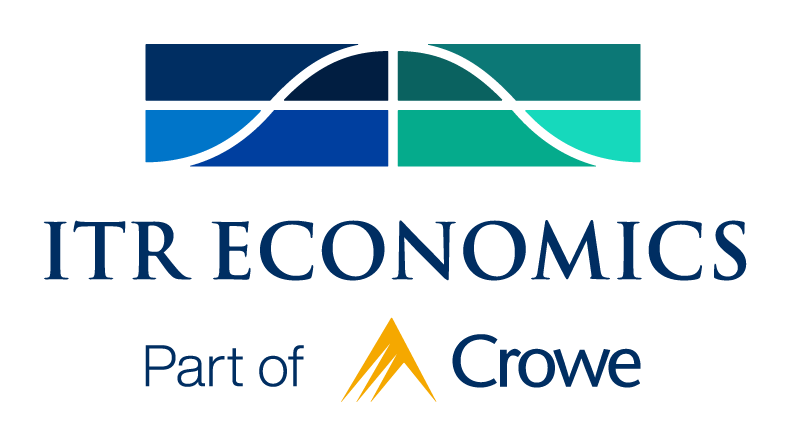September 23, 2024
- Home
- portfolio
- TrendsTalk
- September 23, 2024
DRIVERS OF ONSHORING, NEARSHORING, AND GLOBAL TRADE TRENDS
This week on TrendsTalk, ITR Economist Michael Feuz discusses recent trends in onshoring, nearshoring, and global trade – along with the drivers behind these trends. Watch now to learn about the available opportunities in US private manufacturing construction being fueled by these onshoring investments.

MEET YOUR HOST
Michael Feuz
Michael Feuz is a key member of ITR Economics’ team of expert economists and consultants. Backed by a decade of experience working for technology start-ups, he contributes to the production of client reports, forecast reviews, economic research, and regular client-facing communications.
“Join me on the TrendsTalk podcast to explore the world of economics. Episodes offer insightful discussion and expert interviews. We cover relevant economic concepts in an accessible way. Whether you are a curious layperson or an industry professional, TrendsTalk is your go-to source for thought-provoking analysis and a deeper understanding of the economic forces shaping our world.”
Key Episode Takeaways
- 0:10 – ITR Economist Michael Feuz filling in for Taylor St. Germain
- 0:37 – Recent onshoring and reshoring trends
- 3:02 – Discussing the drivers of onshoring
- 4:41 – Highlighting global trade patterns6:05 – Opportunities in US private manufacturing construction
The below transcript is a literal translation of the podcast audio that has been machine generated by Notta.
Michael Feuz:
Hello, everyone. I’m Michael Feuz, a speaker and economist here at ITR Economics. I’m filling in for Taylor St. Germain. He’s going to be out for a few weeks, so you’ll get a little bit more in time with me. But don’t worry, Taylor will be back. But I’m looking forward to spending some time with you over the next couple of weeks.
Today, I want to talk about onshoring, nearshoring, global trade, economic nationalism. What are the trends we’re seeing? What does it mean for businesses, and how can you take advantage of opportunities that are out there?
Onshoring really has been generally rising in the U.S., going all the way back to the early 2010s. But that rise has significantly increased at a higher rate, really since coming out of the pandemic. We all know the big driver for that was the supply chain, global supply chain disruptions that we all felt and experienced during that time, the outages on shelves, the exacerbated lead times. This certainly helped contribute to driving up inflation as demand was significantly outpacing the supply available.
Now, when we look at onshoring, nearshoring, we can call it re-shoring, what we’re typically looking at is a combination of both jobs and FDI. Both of them are rising. We’re seeing more jobs come back to the U.S. We’re seeing continued foreign direct investment coming into the U.S. People still trust the U.S. Certainly, that’s a different story when we look at China.
These jobs that are coming back to the U.S. and this onshoring, when we look at what areas of the U.S. that are receiving the bulk of those jobs, that is the southern region, which according to a re-shoring initiatives, our friends over there, they’ve reported about 56% of onshoring jobs in the foreign direct investment. 56% of that combined total has gone into southern states. Coming in second is the Midwest at about 22%. The jobs that this onshoring, re-shoring has been favoring primarily are in two areas, the electrical equipment and appliances and components and computers and electronic products. Together, they equal about 64% total of the onshoring that we’re seeing come back to the U.S.
Now, looking at a survey that the re-shoring initiative also put out where they ask businesses what’s driving your onshoring initiatives, the number one reason on that survey was government. On one hand, which is pretty broad, so let’s break that down.
On one hand, we think about U.S. government. If we look at government spending, a data series that we’ve been following more closely is called U.S. Treasury Issuances, which that series tells shows us the debt the Treasury is issuing to make up the delta between the revenue they generate from taxes and the amount of spending they want to do.
Currently, the debt we’re issuing is above the pandemic levels. We’re spending an astronomical amount of money. A lot of that money is going into incentivizing businesses to come back into the U.S. Similarly, individual states are also creating incentives to draw jobs away from other countries back into the United States.
Now, second on the list was proximity to customers and markets. I think this really speaks to the desire to shorten supply chains and secure them. We had the offshoring 20-plus years ago, favoring cost advantage after experience. Starting before the pandemic, we’ve been moving at it for some time now, the growth, the return home, but the pandemic and the geopolitical tensions that still exist out there is encouraging that movement back closer to customer shortness, supply chains, and to my overall markets.
Now, if we look at Census Bureau, I want to talk a little about global trade here. Mexico, now our top trading partner. It has surpassed China. Number two is our Canadian, our neighbors to the north. Number one is Mexico. Number two, Canada. China’s coming in at number three. A surprising statistic, through June of 2024, China only accounts for 10.4% of our total trade. I think this is a little bit of a surprising statistic. I think the overall perception is they pick up a larger portion of the pie. But Mexico, Canada, and the US’s key trading partners in Europe, actually captures about 46.5% of total trade with the US.
So not only do we have onshoring, there’s an active strategic initiative towards what I think could be best described as friendshoring. Who’s my friends? Who do I trust to remain my friend? Admits geopolitical tensions. So if I’m not onshoring, I’m friendshoring.
And then ITR, we recommend a China plus one, or a China plus one plus one strategy. Meaning if you’re still sourcing from China, you should be actively looking to diversify your sourcing, and decoupling as much as you can from China. So if those geopolitical tensions with Taiwan looming do bubble over into something more significant, you’re well positioned to work through that.
Now, I want to look a little bit more into some opportunities that onshoring is providing. And one statistic that stuck out to me, or one series that stuck out to me, was US Private Manufacturing Construction, which is currently in phase C slowing growth. So the growth rate is slowing, but it’s currently still at 34.4% on a 12/12 rate of change. That’s $215.7 billion in new Private Manufacturing Construction in the US over the past 12 months.
These levels of investments really demonstrate the ongoing opportunity that onshoring is driving. Now, think about it. If you’re not directly involved in the construction of these facilities, there’s still opportunity. All of these facilities need industrial controls, electrical equipment, and components. They need to be outfitted as they’re built, offering substantial opportunity.
There’s a lot of money that is being spent that needs to be spent that’s going to create that opportunity for businesses here in the United States. So consider looking at market opportunities that are being driven by onshoring. This can be growth opportunities, but also an opportunity to offset any maybe softness that you’re seeing in your traditional markets. Look to those areas where maybe you don’t feel a little decline over here. This is a way to offset it in the near term and grow your market share over the long term.
So I’ll leave it there today. Again, our Michael Feuz, economist and speaker here at ITR Economics. I’m looking forward to joining you the next couple of weeks here on TrendsTalk while Taylor is out of the office for a couple of weeks. But look forward to joining one, and I’ll see everyone soon.





